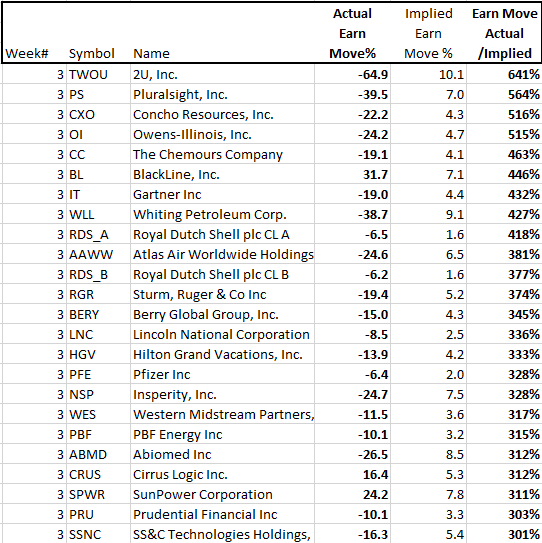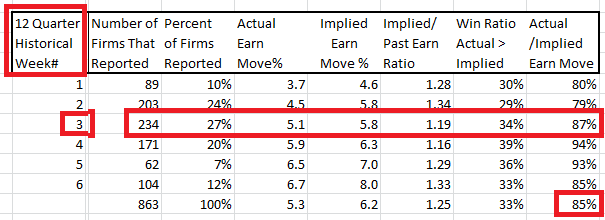Earnings
Monday, August 5th 2019
The Wildest Earnings Week on Record
ORATS reports on stock performance vs implied earnings season move expectation as estimated from the options straddles less residual straddle value.
Summary
ORATS reports that last week was the wildest earnings week in their 3-year study, with actual moves divided by estimated moves hitting 114% for the 338 firms they track. Straddle buyers saw big moves from 2U Inc, Pluralsight, Concho Resources, and Owens-Illinois. The low actual move to implied move ratio suggests that options straddles are usually priced richly coming into earnings announcements, possibly due to investors protecting their stock positions. ORATS estimates the residual value of the straddle after earnings by making an estimate of implied volatility after earnings and a probability distribution for the earnings move.
Last week was the wildest earnings week of any in the ORATS 3-year study, as measured by the average actual moves divided by the estimated moves. Earnings season starts a couple of weeks after quarter-end, at either mid-January, April, July or October, and runs for about 6 weeks. Each week during earnings season, ORATS publishes earnings statistics. ORATS also tracks earnings seasons weekly average results for a rolling three year period to establish comparable results for each week of earnings.
For the firms that have announced, the big number that options traders watch is the move in the stock after earnings announcement compared to what was expected as measured by the options straddle.
Last week was week number 3 of 6. Straddle buyers saw the actual moves divided by the implied moves hit 114% for the 338 firms reporting that ORATS tracks.
The big movers we led by 2U Inc with its stock price down -64.9% posted a 641% move vs expected and Pluralsight, Concho Resources, and Owens-Illinois each had over 500% moves vs expected.

Historically the actual move to implied move ratio has hovered around 85% for all weeks and 87% for week 3. This low ratio shows that the straddle is usually priced richly coming into the earnings announcement. One theory for the richness is that investors are protecting their stock positions buy buying options straddles around earnings, driving up the price of the straddle vs how much stocks actually move.

An options straddle is the simultaneous buying of a call and put option at the same strike in hopes that the stock will move farther away from the strike by expiration than the price of the straddle.
To find the expectation of the earnings move from a straddle, you need the price of the straddle before earnings (this is known), and the estimated residual value of the straddle after earnings (this needs to be calculated). To find that residual value, an estimate of the implied volatility after earnings is made along with a probability distribution for the earnings move. ORATS has been estimating this value and checking the value against actual moves for years now.
Like this kind of information? Sign up for more at https://info.orats.com/earnings
Disclaimer:
The opinions and ideas presented herein are for informational and educational purposes only and should not be construed to represent trading or investment advice tailored to your investment objectives. You should not rely solely on any content herein and we strongly encourage you to discuss any trades or investments with your broker or investment adviser, prior to execution. None of the information contained herein constitutes a recommendation that any particular security, portfolio, transaction, or investment strategy is suitable for any specific person. Option trading and investing involves risk and is not suitable for all investors.
All opinions are based upon information and systems considered reliable, but we do not warrant the completeness or accuracy, and such information should not be relied upon as such. We are under no obligation to update or correct any information herein. All statements and opinions are subject to change without notice.
Past performance is not indicative of future results. We do not, will not and cannot guarantee any specific outcome or profit. All traders and investors must be aware of the real risk of loss in following any strategy or investment discussed herein.
Owners, employees, directors, shareholders, officers, agents or representatives of ORATS may have interests or positions in securities of any company profiled herein. Specifically, such individuals or entities may buy or sell positions, and may or may not follow the information provided herein. Some or all of the positions may have been acquired prior to the publication of such information, and such positions may increase or decrease at any time. Any opinions expressed and/or information are statements of judgment as of the date of publication only.
Day trading, short term trading, options trading, and futures trading are extremely risky undertakings. They generally are not appropriate for someone with limited capital, little or no trading experience, and/ or a low tolerance for risk. Never execute a trade unless you can afford to and are prepared to lose your entire investment. In addition, certain trades may result in a loss greater than your entire investment. Always perform your own due diligence and, as appropriate, make informed decisions with the help of a licensed financial professional.
Commissions, fees and other costs associated with investing or trading may vary from broker to broker. All investors and traders are advised to speak with their stock broker or investment adviser about these costs. Be aware that certain trades that may be profitable for some may not be profitable for others, after taking into account these costs. In certain markets, investors and traders may not always be able to buy or sell a position at the price discussed, and consequently not be able to take advantage of certain trades discussed herein.
Be sure to read the OCCs Characteristics and Risks of Standardized Options to learn more about options trading.
Related Posts



